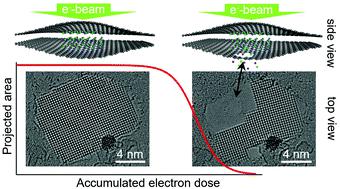Our official English website, www.x-mol.net, welcomes your
feedback! (Note: you will need to create a separate account there.)
Quasi-two-dimensional NaCl crystals encapsulated between graphene sheets and their decomposition under an electron beam
Nanoscale ( IF 5.8 ) Pub Date : 2021-11-01 , DOI: 10.1039/d1nr04792b Tibor Lehnert 1, 2 , Silvan Kretschmer 3 , Fredrik Bräuer 1 , Arkady V Krasheninnikov 3, 4 , Ute Kaiser 1
Nanoscale ( IF 5.8 ) Pub Date : 2021-11-01 , DOI: 10.1039/d1nr04792b Tibor Lehnert 1, 2 , Silvan Kretschmer 3 , Fredrik Bräuer 1 , Arkady V Krasheninnikov 3, 4 , Ute Kaiser 1
Affiliation

|
Quasi-two-dimensional (2D) sodium chloride (NaCl) crystals of various lateral sizes between graphene sheets were manufactured via supersaturation from a saline solution. Aberration-corrected transmission electron microscopy was used for systematic in situ investigations of the crystals and their decomposition under an 80 kV electron beam. Counterintuitively, bigger clusters were found to disintegrate faster under electron irradiation, but in general no correlation between crystal sizes and electron doses at which the crystals decompose was found. As for the destruction process, an abrupt decomposition of the crystals was observed, which can be described by a logistic decay function. Density-functional theory molecular dynamics simulations provide insights into the destruction mechanism, and indicate that even without account for ionization and electron excitations, free-standing NaCl crystals must quickly disintegrate due to the ballistic displacement of atoms from their surface and edges during imaging. However, graphene sheets mitigate damage development by stopping the displaced atoms and enable the immediate recombination of defects at the surface of the crystal. At the same time, once a hole in graphene appears, the displaced atoms escape, giving rise to the quick destruction of the crystal. Our results provide quantitative data on the stability of encapsulated quasi 2D NaCl crystals under electron irradiation and allow the conclusion that only high-quality graphene is suitable for protecting ionic crystals from beam damage in electron microscopy studies.
中文翻译:

封装在石墨烯片之间的准二维 NaCl 晶体及其在电子束下的分解
石墨烯片之间具有各种横向尺寸的准二维 (2D) 氯化钠 (NaCl) 晶体是通过盐水溶液的过饱和度制造的。像差校正透射电子显微镜用于系统原位在 80 kV 电子束下研究晶体及其分解。与直觉相反,发现更大的簇在电子辐射下分解得更快,但通常没有发现晶体尺寸与晶体分解的电子剂量之间存在相关性。至于破坏过程,观察到晶体的突然分解,这可以用逻辑衰减函数来描述。密度泛函理论分子动力学模拟提供了对破坏机制的见解,并表明即使不考虑电离和电子激发,由于原子在成像过程中从其表面和边缘的弹道位移,独立的 NaCl 晶体也必须迅速分解。然而,石墨烯片通过阻止移位的原子来减轻损伤的发展,并使晶体表面的缺陷立即重新组合。同时,一旦石墨烯中出现一个孔洞,移位的原子就会逃逸,从而导致晶体的快速破坏。我们的结果提供了在电子辐射下封装的准 2D NaCl 晶体稳定性的定量数据,并得出了只有高质量石墨烯才适合在电子显微镜研究中保护离子晶体免受束损伤的结论。
更新日期:2021-11-24
中文翻译:

封装在石墨烯片之间的准二维 NaCl 晶体及其在电子束下的分解
石墨烯片之间具有各种横向尺寸的准二维 (2D) 氯化钠 (NaCl) 晶体是通过盐水溶液的过饱和度制造的。像差校正透射电子显微镜用于系统原位在 80 kV 电子束下研究晶体及其分解。与直觉相反,发现更大的簇在电子辐射下分解得更快,但通常没有发现晶体尺寸与晶体分解的电子剂量之间存在相关性。至于破坏过程,观察到晶体的突然分解,这可以用逻辑衰减函数来描述。密度泛函理论分子动力学模拟提供了对破坏机制的见解,并表明即使不考虑电离和电子激发,由于原子在成像过程中从其表面和边缘的弹道位移,独立的 NaCl 晶体也必须迅速分解。然而,石墨烯片通过阻止移位的原子来减轻损伤的发展,并使晶体表面的缺陷立即重新组合。同时,一旦石墨烯中出现一个孔洞,移位的原子就会逃逸,从而导致晶体的快速破坏。我们的结果提供了在电子辐射下封装的准 2D NaCl 晶体稳定性的定量数据,并得出了只有高质量石墨烯才适合在电子显微镜研究中保护离子晶体免受束损伤的结论。











































 京公网安备 11010802027423号
京公网安备 11010802027423号